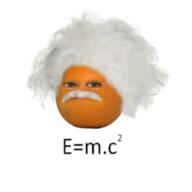Redox reaction
2011-02-15 7:25 am
E/VV3+(aq) + e- à V2+(aq) -0.25SO42-(aq) + 4H+(aq) + 2e- à H2SO3(aq) + H2O(l) +0.17VO2+(aq) + 2H+(aq) + e- à V3+(aq) + H2O(l) +0.36VO2+(aq) + 2H+(aq) + e- à VO2+(aq) + H2O(l) +1.00I2(aq) + 2e- à 2I-(aq) +0.54 Q1: Excess KI(aq) is added to VO2+(aq)2I-(aq) + 2VO2+(aq) + 4H+(aq) à 2VO2+(aq) + 2H2O(l) + I2(aq)E = -0.54 + 1.00 = 0.36V > 0 Q2: Excess SO2(g) is bubbled into VO2+(aq)H2SO3(aq) + 2VO2+(aq) à V3+(aq) + SO42-(aq) + H2O(l)E = -0.17 + 1.00 + 0.36 = 1.19V > 0 In Q1, why KI will not reduce to a greater extent to make the VO2+ à V3+? In Q2, why H2SO3 will not reduce to a greater extent to make the V3+ à V2+?E = 1.00 + 0.36 – 0.17 – 0.25 = 0.94V > 0
回答 (1)
2011-02-15 11:49 pm
✔ 最佳答案
In Q1, why KI will not reduce to a greater extent to make the VO2⁺ → V³⁺? 2VO2⁺ (aq) + 4H⁺(aq) + 2I⁻(aq) → 2VO²⁺(aq) + 2H2O(l) + I2(aq)
Ecell° = (1.00) - (+0.54) = +0.46 > 0
Hence, the above redox reaction is FEASIBLE.
2VO²⁺(aq) + 4H⁺(aq) + 2I⁻(aq) → 4V³⁺(aq) + 2H2O(l) + I2(aq)
Ecell° = (+0.36) - (+0.54) = -0.18 < 0
Hence, the above redox reaction is NOT feasible.
Refer to the above two reactions. KI can convert VO2⁺ to VO²⁺, but NOT further to V³⁺.
= = = = =
In Q2, why H2SO3 will not reduce to a greater extent to make the V³⁺ à V²⁺?
H2SO3(aq) + H2O(l) + 2V3+(aq) → SO42-(aq) + 4H+(aq) + 2V2+(aq)
Ecell° = (-0.25) - (0.17) = -0.42 < 0
Hence, the above reaction is NOT feasible.
In other words, H2SO3 will not reduce V³⁺ to V²⁺.
參考: micatkie
收錄日期: 2021-04-13 17:49:45
原文連結 [永久失效]:
https://hk.answers.yahoo.com/question/index?qid=20110214000051KK01365

